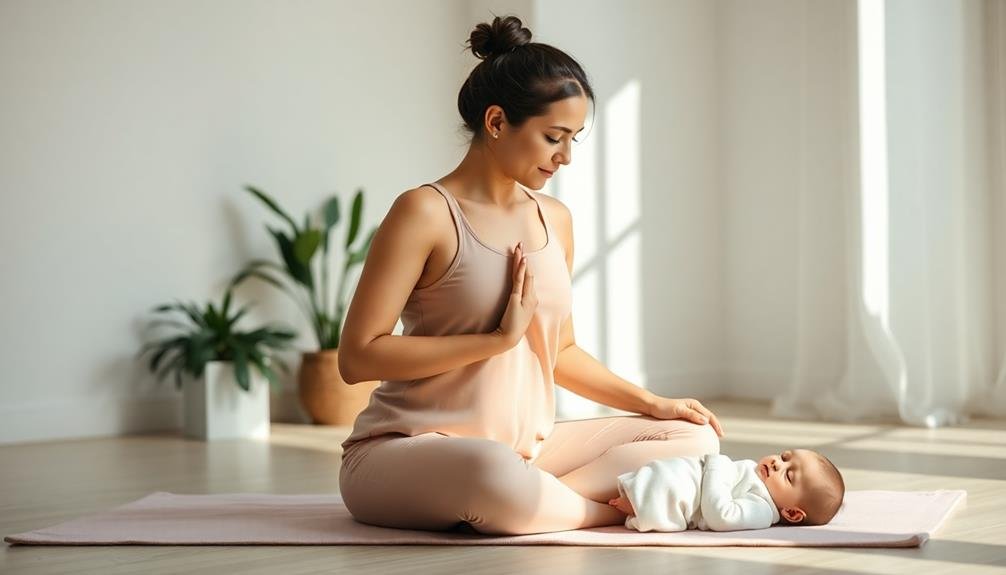Looking for gentle postpartum yoga poses? Try these seven restorative options to ease your body back into movement. Start with Child's Pose for relaxation, then flow through Cat-Cow to stretch your spine. Bridge Pose strengthens your core and pelvic floor, while Legs-Up-the-Wall reduces swelling. Seated Forward Fold and Reclined Twist offer gentle stretches for your back and hamstrings. Finally, unwind with Corpse Pose for meditation and stress relief. Remember to listen to your body and modify as needed. Each pose offers unique benefits to support your postpartum recovery journey.
Key Takeaways
- Child's Pose promotes relaxation and stress relief, ideal for new moms needing a moment of calm.
- Bridge Pose strengthens the pelvic floor and core muscles, aiding postpartum recovery.
- Cat-Cow Stretch enhances spine flexibility and alleviates postpartum back pain.
- Legs-Up-the-Wall Pose reduces swelling and improves circulation in legs and feet.
- Reclined Twist relieves tension in the back and improves spinal mobility for postpartum comfort.
Child's Pose for Relaxation

Child's Pose can help you wind down after a long day of caring for your newborn. This gentle posture allows you to stretch your back, hips, and thighs while promoting relaxation and stress relief.
To begin, kneel on your mat with your knees hip-width apart and your big toes touching. Sit back on your heels and slowly lower your torso between your thighs. Extend your arms in front of you, palms down, and rest your forehead on the mat.
As you settle into Child's Pose, focus on your breath. Take deep, slow breaths, feeling your ribcage expand with each inhale and relax with each exhale. This breathing technique helps calm your nervous system and reduce anxiety.
You can stay in this position for 1-5 minutes, or longer if desired. If you experience discomfort in your knees, place a folded blanket underneath them for support. To modify for a larger chest or belly, widen your knees further apart.
Child's Pose is an excellent way to release tension in your lower back and shoulders, areas often strained from holding and feeding your baby.
Cat-Cow Stretch

While Child's Pose offers relaxation, the Cat-Cow Stretch provides gentle movement to help new moms regain flexibility and strength in their spine. This dynamic pose alternates between two positions, engaging your core and promoting better posture.
To begin, position yourself on all fours with your hands directly under your shoulders and knees beneath your hips. As you inhale, drop your belly towards the floor, lifting your chest and tailbone. This is the "Cow" position. Gaze upward, allowing your back to arch gently.
As you exhale, round your spine towards the ceiling, tucking your chin to your chest and your tailbone under. This is the "Cat" position.
Continue flowing between these two positions, coordinating your breath with each movement. You'll feel a gentle stretch in your back, abdomen, and chest. This pose can help alleviate postpartum back pain, improve circulation, and strengthen your core muscles.
Start with 5-10 repetitions and gradually increase as you feel comfortable. If you've had a C-section, wait until your doctor clears you for exercise before attempting this pose.
Always listen to your body and stop if you experience any pain or discomfort.
Bridge Pose

As you progress in your postpartum yoga journey, the Bridge Pose offers an excellent way to strengthen your pelvic floor and core muscles. This gentle backbend also helps improve posture and relieve lower back pain, common issues for new moms.
To perform the Bridge Pose, lie on your back with your knees bent and feet flat on the floor, hip-width apart. Place your arms alongside your body, palms facing down.
As you inhale, lift your hips off the ground, engaging your glutes and core muscles. Keep your shoulders and head on the mat, creating a straight line from your knees to your shoulders. Hold this position for 5-10 breaths, focusing on your breath and maintaining the engagement of your muscles.
If you're comfortable, you can clasp your hands together under your back and roll your shoulders underneath you for a deeper stretch. Remember to listen to your body and avoid pushing yourself too hard.
As you exhale, slowly lower your hips back to the ground, vertebra by vertebra. Repeat this pose 3-5 times, gradually increasing the duration as you build strength and flexibility.
Legs-Up-the-Wall Pose

Restorative and rejuvenating, the Legs-Up-the-Wall Pose is a fantastic option for new moms looking to relax and reduce swelling in their legs and feet. To practice this pose, find a clear wall space and lie on your back with your legs extended up the wall. Your buttocks should be as close to the wall as comfortable. Rest your arms by your sides, palms facing up. Close your eyes and focus on your breath, allowing tension to melt away.
This pose offers numerous benefits for postpartum recovery:
| Benefit | How It Helps | Duration |
|---|---|---|
| Reduces swelling | Improves circulation | 5-15 minutes |
| Relieves back pain | Decompresses spine | 5-10 minutes |
| Calms the mind | Promotes relaxation | 10-20 minutes |
| Eases fatigue | Restores energy | 5-15 minutes |
| Improves sleep | Reduces insomnia | 10-20 minutes |
Start with shorter durations and gradually increase as you feel comfortable. If you experience any discomfort, gently lower your legs and rest. Remember to breathe deeply and listen to your body. This pose can be especially beneficial after long periods of standing or sitting, helping to refresh and rejuvenate your tired legs and feet.
Seated Forward Fold

The Seated Forward Fold offers new moms a gentle stretch for tight hamstrings and lower back muscles.
You'll start by sitting on the floor with legs extended, then hinge at the hips to reach for your toes while keeping your spine long.
If you can't reach your toes, you can use a strap or hold onto your shins, focusing on the stretch rather than how far you can fold.
Benefits for New Moms
Seated Forward Fold offers numerous benefits for new moms recovering from childbirth. This gentle pose helps stretch your lower back, hamstrings, and calves, areas that may have become tight during pregnancy and delivery. As you fold forward, you'll feel a gentle release of tension in your spine, promoting better posture and reducing back pain.
This pose also encourages introspection and relaxation, allowing you to take a few moments for yourself amidst the demands of motherhood. It can help calm your mind, reduce stress, and alleviate anxiety, which are common challenges for new moms.
The forward-folding action stimulates your digestive system, potentially aiding in postpartum recovery and improving overall gut health. You'll also experience improved circulation throughout your body, particularly in your pelvic area. This increased blood flow can support healing and reduce swelling in your lower extremities.
Additionally, Seated Forward Fold strengthens your core muscles, which may have weakened during pregnancy. By practicing this pose regularly, you'll gradually rebuild abdominal strength, supporting better posture and reducing the risk of back pain as you care for your newborn.
Proper Technique and Modifications
To perform Seated Forward Fold correctly, begin by sitting on your mat with your legs extended straight in front of you. Flex your feet, pointing your toes towards the ceiling. Sit up tall, lengthening your spine and engaging your core.
As you inhale, raise your arms overhead, then exhale and hinge forward from your hips. Reach for your toes or ankles, keeping your back straight and chest open.
If you can't reach your feet, don't force it. Instead, place your hands on your shins or use a yoga strap around your feet. For added support, sit on a folded blanket to elevate your hips.
If you're experiencing diastasis recti, modify by keeping your knees slightly bent and focusing on lengthening your spine rather than folding deeply.
Hold the pose for 30 seconds to a minute, breathing deeply. To release, slowly roll up vertebra by vertebra, letting your head come up last.
Remember to listen to your body and never push beyond your comfort level. As a new mom, your body is still healing, so it's important to be gentle and patient with yourself during this practice.
Reclined Twist

Twisting gently can help relieve tension in your back and improve spinal mobility after pregnancy. The reclined twist is an excellent postpartum yoga pose that's both restorative and beneficial for your spine and abdominal muscles.
To perform this pose, lie on your back with your knees bent and feet flat on the floor. Extend your arms out to the sides in a T-shape, palms facing up. As you exhale, slowly lower both knees to one side while keeping your shoulders flat on the ground. Turn your head in the opposite direction of your knees for a gentle neck stretch.
This pose offers several benefits for new moms:
- Aids in digestion and relieves gas
- Stretches the lower back, glutes, and obliques
- Promotes relaxation and stress relief
Hold the pose for 5-10 deep breaths, then slowly return to center and repeat on the other side. If you've had a C-section, wait until your incision has fully healed before attempting this pose.
To modify, place a pillow between your knees for added support. Remember to listen to your body and never force the twist beyond your comfort level. Gradually increase the intensity of the twist as you regain strength and flexibility postpartum.
Corpse Pose for Meditation

Relaxation is essential for new moms, and the Corpse Pose (Savasana) offers a perfect opportunity for meditation and rest.
To practice this pose, lie on your back with your legs slightly apart and your arms relaxed by your sides, palms facing up. Close your eyes and focus on your breath, allowing your body to sink into the floor.
As you settle into the pose, scan your body from head to toe, consciously releasing tension in each muscle group. Pay attention to areas that often hold stress, such as your jaw, shoulders, and lower back.
If you find it difficult to quiet your mind, try counting your breaths or repeating a calming mantra.
Corpse Pose can be especially beneficial for new moms dealing with sleep deprivation and physical recovery. It helps reduce stress, lower blood pressure, and promote overall relaxation.
Even just a few minutes in this pose can leave you feeling refreshed and rejuvenated.
If you're struggling with postpartum discomfort, place a small pillow under your knees or head for added support.
Frequently Asked Questions
When Is the Best Time to Start Postpartum Yoga?
You can start postpartum yoga as soon as you feel ready and have your doctor's approval. It's typically safe to begin gentle poses around 6 weeks after delivery, but listen to your body and don't rush into it.
Can I Practice Yoga While Breastfeeding?
Yes, you can practice yoga while breastfeeding. It's safe and beneficial for both you and your baby. You'll improve circulation, reduce stress, and enhance milk production. Just be mindful of your body's needs and choose comfortable poses.
How Often Should I Do Postpartum Yoga?
You can start with short, 10-15 minute sessions 2-3 times a week. As you feel stronger, gradually increase to 30-45 minute sessions 3-4 times weekly. Listen to your body and don't push too hard too soon.
Are There Any Poses I Should Avoid After a C-Section?
After a C-section, you'll want to avoid poses that strain your abdominal muscles. Don't do twists, backbends, or core-intensive poses. Stick to gentle stretches and breathing exercises. Always consult your doctor before starting any postpartum exercise routine.
Do I Need Special Equipment for Postpartum Yoga at Home?
You don't need much special equipment for postpartum yoga at home. A yoga mat, comfortable clothes, and some pillows or blankets for support are usually enough. If you'd like, you can also use yoga blocks or straps.
In Summary
You've now got a great set of gentle yoga poses to help you ease back into exercise after giving birth. Remember to listen to your body and don't push yourself too hard. Start slowly and gradually increase your practice as you feel comfortable. These poses will help you relax, stretch, and strengthen your postpartum body. Always consult with your doctor before beginning any exercise routine. Enjoy this special time with your new baby and your evolving body.





Leave a Reply